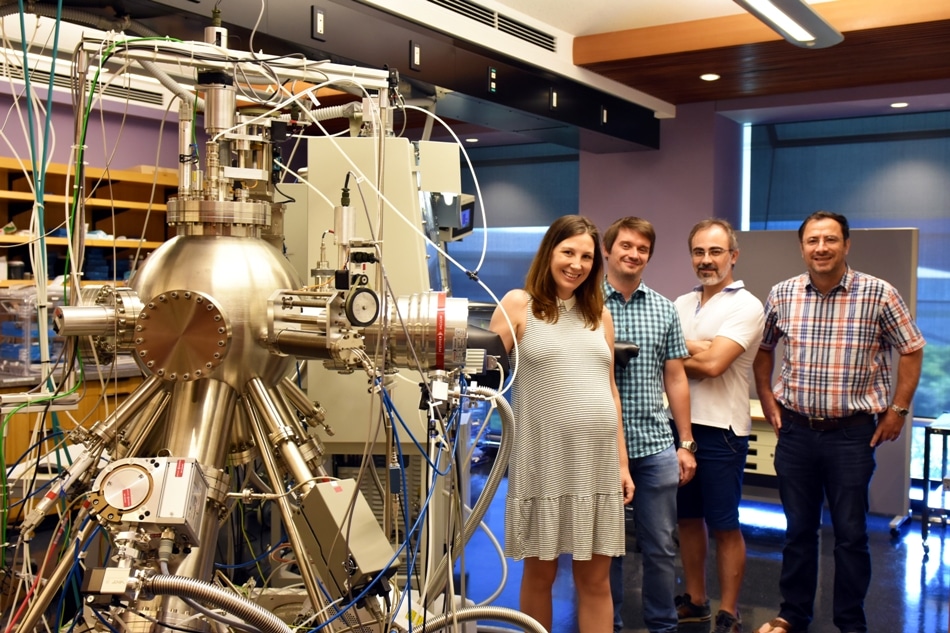Sep 7 2017
There is a progressively increasing need for larger high-performance batteries as the world tries to move towards renewable energy from fossil fuels, but at the same time depending a lot more on energy-guzzling devices.
 Members of the Nanoparticles by Design Unit besides the Cluster Beam Deposition machine used to manufacture the new silicon anode. (Credit: OIST)
Members of the Nanoparticles by Design Unit besides the Cluster Beam Deposition machine used to manufacture the new silicon anode. (Credit: OIST)
Most of today’s portable electronics are powered by lithium-ion batteries (LIBs), but they are flammable and can even explode, as it happened to a recent smartphone model. To prevent such accidents, the present solution is to encapsulate the anode - which is the negative (-) electrode of the battery, opposite to the cathode (+) - into a graphite frame, thereby insulating the lithium ions. However, such casing is restricted to a small scale to avoid physical breaking, thus limiting the capacity of the battery.
Searching for better materials, silicon gives more advantages than carbon graphite for lithium batteries with regards to capacity. Six atoms of carbon are needed to bind a single atom of lithium, while an atom of silicon can bind four atoms of lithium at the same time, multiplying the battery capacity by over 10-fold. However, being able to trap so many lithium ions means that the volume of the anode grows by 300% to 400%, causing fracturing and loss of structural integrity. To resolve this issue, OIST Researchers have recently reported in Advanced Science the design of an anode constructed on nanostructured layers of silicon – quite like a multi-layered cake – to preserve the benefits of silicon while preventing physical failure.
This new battery design is also aiming to enhance power, which is the ability to charge and supply energy over time.
The goal in battery technology right now is to increase charging speed and power output. While it is fine to charge your phone or your laptop over a long period of time, you would not wait by your electric car for three hours at the charging station.
Dr. Marta Haro Remon, First Author of the study
And with regards to providing energy, a driver would want the car to start off quickly at traffic lights or a stop sign, requiring a high increase in power, rather than sluggishly creeping forward. A properly planned design of a silicone-based anode might be a solution and can meet these expectations.
The concept behind the new anode in the Nanoparticles by Design Unit at the Okinawa Institute of Science and Technology Graduate University is the ability to exactly control the synthesis and the corresponding physical structure of the nanoparticles. Unstructured silicon films are deposited alternatively with tantalum metal nanoparticle scaffolds, causing the silicon to be sandwiched in a tantalum frame.
We used a technique called Cluster Beam Deposition. The required materials are directly deposited on the surface with great control. This is a purely physical method, there are no need for chemicals, catalysts or other binders.
Dr. Marta Haro Remon, First Author of the study
The result of this research, led by Professor Sowwan at OIST, is an anode with higher power but restrained swelling, and superior cyclability – the number of cycles in which a battery can be charged and discharged prior to losing efficiency. By analyzing the nanostructured layers of silicon a little more closely, the Researchers realized the silicon exhibits important porosity with a grain-like structure in which lithium ions could move at higher speeds compared to unstructured, amorphous silicon, explaining the spike in power.
Simultaneously the presence of silicon channels along the tantalum nanoparticle scaffolds permits the lithium ions to diffuse in the whole structure. Conversely, the tantalum metal casing, while limiting swelling and enhancing structural integrity, also restricted the total capacity – for now.
However, this design is presently only at the proof-of-concept stage, paving the way to several opportunities to enhance capacity together with the increased power.
It is a very open synthesis approach, there are many parameters you can play around. For example, we want to optimize the numbers of layers, their thickness, and replace tantalum metal with other materials.
Dr. Marta Haro Remon, First Author of the study
With this method, it might very well be the answer for future batteries, estimated to be ubiquitous in our lives, will be found in nanoparticles.